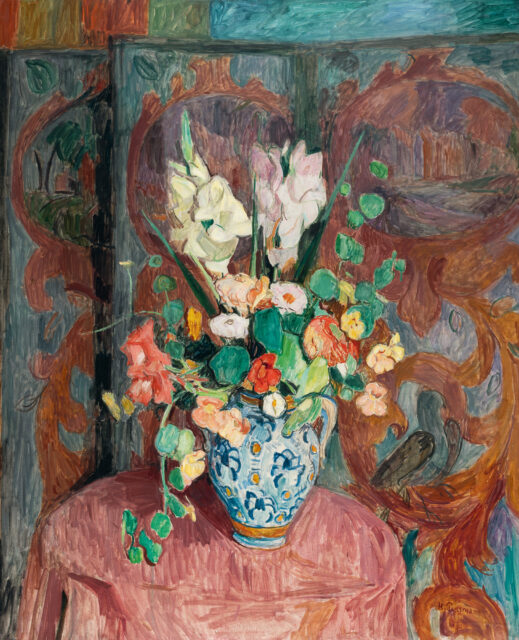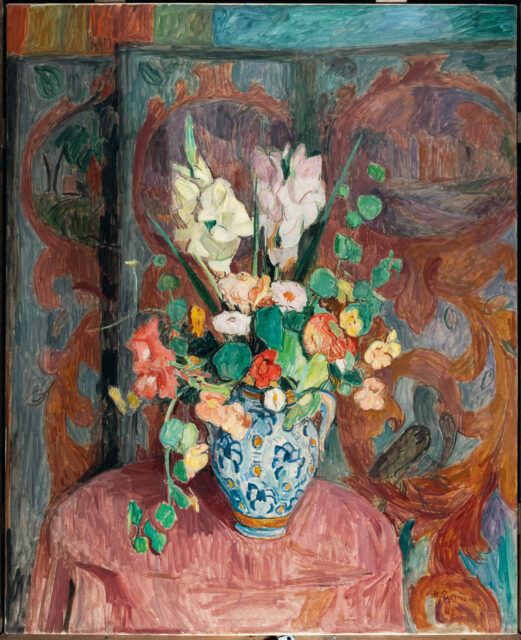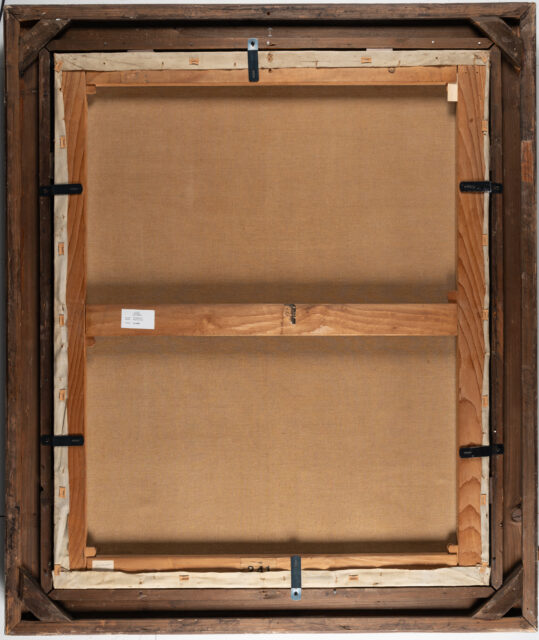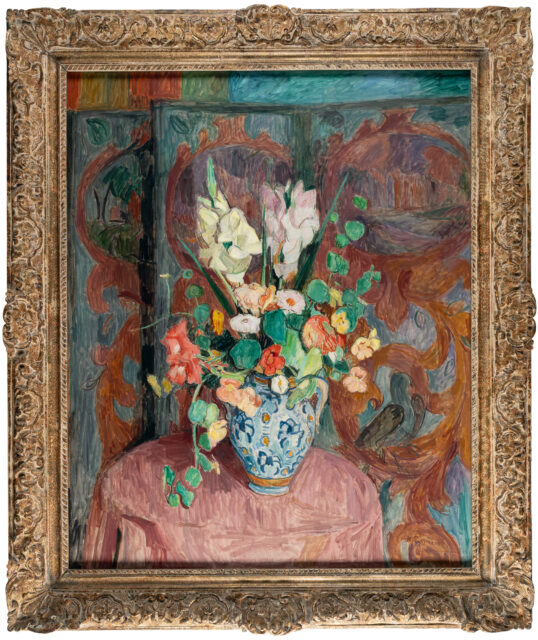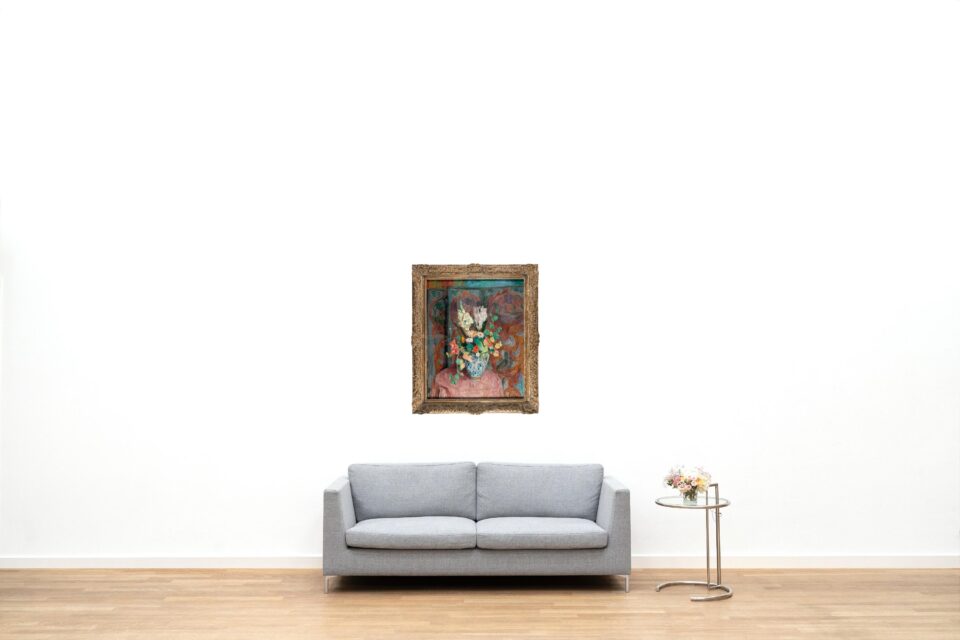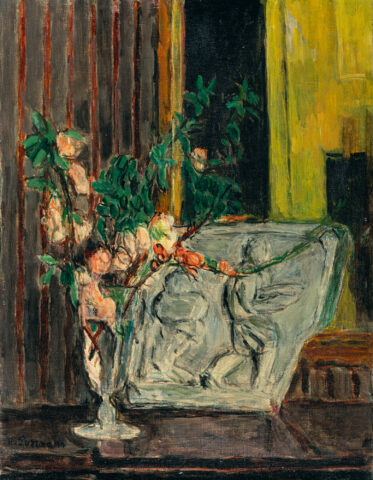
Still life with gladioli and nasturtiums
Details
Provenance:
Kunsthandel Lucas Lichtenhan, Basel, inscribed by hand on the reverse of the frame;
Ottilie Voigt, Romanshorn, probably acquired from the aforementioned;
Privately owned, Karlsruhe, received by inheritance;
Privately owned, Hamburg, passed on in the family to the present owners;
Private property, Baden-Württemberg.
Descrizione
– Great colourist of modernism
– Through the modulation of the colours, starting from the four tones of blue-orange, red-green, Purrmann achieves an exciting unity
– Purrmann’s passion for collecting rare objects is also evident in this work
Hans Purrmann was born as the son of a painter and plasterer in Speyer in 1880 and, after early stages at the Karlsruhe School of Arts and Crafts and at the Academy in Munich under Franz von Stuck and at the Académie Matisse in Paris, found his very own artistic style, which shows his preference for light-flooded interiors, Mediterranean landscapes and still lifes. Although his painting reveals clear influences from the French artists Matisse, Cézanne and Renoir, Purrmann found his very own style of painting, which impressively combines form and colour.
According to Robert Purrmann, the artist’s son, the undated, large-format “Still Life with Gladioli and Nasturtium” was created in 1926 in Langenargen on Lake Constance. Purrmann spent the summers there with his family after purchasing a fisherman’s house directly on the lake in 1919.
Purrmann’s passion for collecting paintings, prints, carpets, antiques and special objects comes to the fore in the present painting. The magnificent majolica vase filled with gladioli, zinnias and nasturtiums with floral decoration, which stands in the centre of the picture on a small round table with a tablecloth, can be found in several of the artist’s still lifes. Purrmann’s collector’s items repeatedly find their way into his works. Purrmann captures both the vase and the flowers in fine, precise brushstrokes in bright shades of yellow, red, green and blue, clearly emphasising their significance against the otherwise more tonal colours. Purrmann’s love of fabrics, which he shared with his friend and teacher Matisse, plays an important role in the background of the painting. The colourful ornamental screen can also be found in other works by Purrmann and appears in interior scenes from his studio in Langenargen from around 1920. Purrmann incorporates the colourful, somewhat muted screen completely into the depiction. The picture planes almost seem to blend together. The viewer has the feeling that the depictions on the screen merge with the flowers and the vase with the handle. The parrot depicted on the right-hand edge of the screen seems almost real. Despite this perceived connection between the objects depicted, their intrinsic value is retained. Purrmann brings the still life to full effect and development through the abundance and opulence of the depiction. An impressive example of his love for this subject.
In 1995, on the occasion of the exhibition ‘Hans Purrmann. Im Licht der Farbe’ (In the Light of Colour) on his still lifes: “Through the modulation of the colours, starting from the four-tone harmony of blue-orange, red-green, Purrmann achieves an exciting unity that can be underlined with the words of Matisse: You have to have a large and clear disposition in order to be able to set three or four contrasts correctly; the further meaning of the colour takes place between these. Painting is nothing but the observation of colour relationships to one another; one must see in the ensemble (…)”.
* Tutte le informazioni includono la commissione a carico dell'acquirente (27%) senza IVA e senza garanzia. Salvo errori.
** Tutte le informazioni più la commissione a carico dell'acquirente e l'IVA e senza garanzia. Salvo errori.
*** Con riserva: L'offerta è stata accettata al di sotto del limite. L'acquisizione dell'opera potrebbe essere ancora possibile nella nostra vendita post-asta.
R = Le opere d'arte regolarmente tassate
N = Opere d'arte soggette a tassazione differenziata e provenienti da un paese non UE
Non è consentita la riproduzione e la distribuzione privata o commerciale di tutte le illustrazioni delle opere esposte nell'archivio della mostra e dell'asta. Tutti i diritti riservati.


